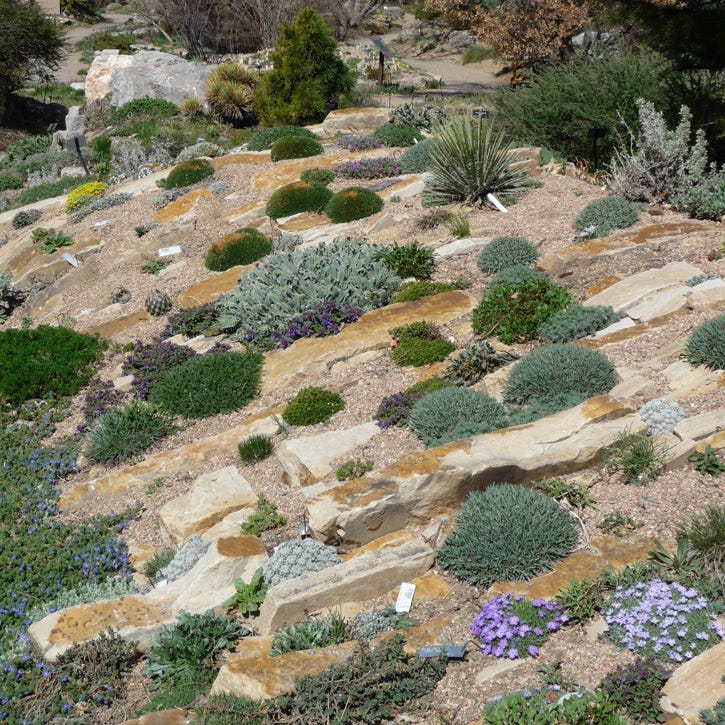by High Country Gardens
Images From The Denver Botanic Garden's Crevice Rock Gardens
 The Denver Botanic Garden's Crevice Rock Gardens in early April. Photo by Wendy Hatoum
The Denver Botanic Garden's Crevice Rock Gardens in early April. Photo by Wendy Hatoum
Rock gardening is a very popular style of gardening that uses small growing plants to create miniature landscapes. A majority of these plants come down from the mountains and other high elevation regions of the world. And these hardy little plants often have deep growing tap roots that need a fast draining soil. For many parts of the US, providing excellent drainage can be a challenge. Ample rain and snowfall keeps soils moister than many rock garden plants prefer.
Thank You Czech Republic
Well, leave it to the Czechs, who are some of the most avid of the European rock gardeners and whose ranks include some of the most accomplished wild plant seed collectors, to come up with a fantastic new rock gardening technique known as the "crevice garden." Instead of placing rocks into the soil berms (mounds of soil) from the side like stepping stones up the side of a hill, they use flat stones (such as pieces of flagstone or slate) that are pushed down into the soil vertically from the top. These vertical pieces are closely spaced leaving deep, narrow channels of soil that for planting.
 Crevice gardening allows rock gardeners to successfully cultivate a wider palette of plants. Denver Botanic Garden in early April. Photo by Wendy Hatoum)
Crevice gardening allows rock gardeners to successfully cultivate a wider palette of plants. Denver Botanic Garden in early April. Photo by Wendy Hatoum)
This technique provides optimum growing conditions by limiting the amount of soil around the roots. And the rocks help to channel rain and snow melt water down more deeply into the soil encouraging deeper root growth while keeping the soil dry around the crown. Crevice gardening has been a game changing technique allowing rock gardeners to successfully cultivate a wider palette of plants including some that have been considered intractable (ungrowable) or limited to hypertufa trough culture.
Lean, Well-Drained Soil for the Crevice Garden
To create a lean, well-drained soil for your crevice garden, I recommend mixing by volume, 1/2 soil and 1/2 large perlite (or small crushed gravel or expanded shale pellets) and Yum Yum Mix at recommended rates.
Planting Techniques for Crevices
When planting a crevice garden, the first question that comes to mind is how to wedge the rootball of a potted plant into the narrow crevice between two vertical rocks? Even plants grown in small 2 1/2" wide pots are too wide. Bare-root planting is required.
Here are the steps.
- Let the soil in the to-be-transplanted plants dry down a bit so that the soil mix can be readily separated from the roots. (It's very difficult to bare-root a plant in soggy soil.)
- Trim off excess hair roots with scissors or sharp clippers (remove about 1/4 to 1/3 of the bottom fine, hanging roots), but don't cut the tap-root.
- Using a narrow planting trowel, a Hori Hori gardening knife or weed fork, push aside the soil and gently lower the roots straight down into the hole.
- Then fill the hole with loose soil and firm into place.
- Water twice: once with clear water and again 5 to 10 minutes later with a mix of SuperThrive and liquid seaweed (Root Stimulator Combo Pack).
- Mulch with 1/2" of fine crushed gravel.
- Finally, position a couple of rocks leaning on each other, such that it shades the plant from the sun. Leave the rocks there for about a week to 10 days to help the plant re-establish its roots.
The Timing of Bare-Root Planting
Plants are best planted bare-root before daytime temperatures become too hot. So early to mid-spring and fall are optimum times. But by providing shade and regular irrigation, bare-root planting can also be done later in the spring and even into the summer months.
 Crevice gardens are especially good for growing xeric plants including cold hardy cacti and South African succulents. (Denver Botanic Garden Crevice Rock Garden in early April. Photo by Wendy Hatoum)
Crevice gardens are especially good for growing xeric plants including cold hardy cacti and South African succulents. (Denver Botanic Garden Crevice Rock Garden in early April. Photo by Wendy Hatoum)
Not Just for Tiny Plants
Crevice gardens are especially good for growing cold hardy cacti, South African succulents and other xeric plants whose roots are sensitive to wet soil conditions. This is also a great way to grow larger growing xeric (low water plants) like Hummingbird Mint (Agastache), Lavender (Lavandula), Sundance Daisy (Hymenoxys), Beardtongue (Penstemon) and native Sage (Salvia) in moister climates. Just make a berm using a well drained soil mix (see above). Bury some big flat rocks close together to create a vertical pocket crevice and plant.
Text by David Salman
© All articles are copyrighted by High Country Gardens. Republishing an entire High Country Gardens blog post or article is prohibited without permission. Please feel free to share a short excerpt with a link back to the article on social media websites, such as Facebook and Pinterest.